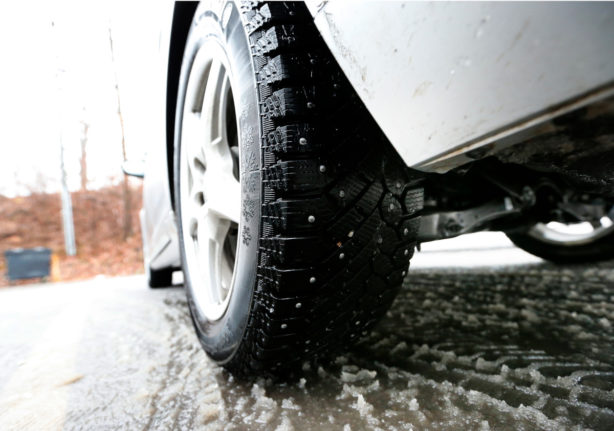Swedish weather can be changeable at this time of year, switching from spring sun and showers to snow and ice storms and freezing cold temperatures. If you plan to drive in these types of road conditions, you need to be prepared. We’ve gathered together our best tips:
Prep your car
Change to winter tyres. Swedish law states that all cars must be equipped with winter tyres between December 1st and March 31st if the weather conditions require it.
If your car doesn’t have them or if they are not up to scratch (a tread depth of at least three millimetres), you risk a fine of 1,200 kronor.
There are no rules against putting winter tyres on your car early or keeping them on past March 31st, so be sure to check the weather forecast and wait until the risk of snow and frost has passed before you change to summer tyres.
Winter tyres radically decrease the risk of skidding and improve a vehicle’s overall braking capacity on slippery surfaces, reducing the risk of accidents.
In general, studded winter tyres are better suited for icy roads or on surfaces with hard-packed snow, while stud-free tyres work better on roads with soft snow. Pay attention though: studded tyres are illegal on some streets in major Swedish cities for air pollution reasons.
Studded tyres are allowed between October 1st and April 15th, or in wintery driving conditions.
Make sure the windshield wiper fluid contains anti-freeze. And remember to check the temperature range it can handle – if you’re driving to Sweden from a warmer country your windshield wiper fluid may not be suitable for very cold temperatures. That means it could freeze or even, in the worst-case scenario, crack the tank.
Check the car lights. Visibility decreases radically in winter conditions, especially during storms.
Equip your car for emergencies. In case you get stuck in the snow, make sure to always have a warm set of clothes and a blanket in your car. It’s also a good idea to have an ice scraper, a shovel, a torch, a tow-rope, a reflective vest, starting cables and a bag of sand (sand helps the tyres get a grip). Also stock up on fast energy foods, such as raisins or candy, as well as tealights or candles, matches and a lighter to keep warm.
How to drive
Driving on a winter surface requires different skills and reflexes than we are used to. Plan your car’s movements in advance, since the more slippery surface adds to the risk of losing control of the car, and makes braking distances far longer. You should therefore:
– Avoid braking abruptly.
– If you still have to brake, and your car is not equipped with an ABS-braking system, use the “pump-braking” method, meaning you first step on the brakes and then let go to, then step on them again. This prevents the wheels from locking (which will cause the car to skid). If your car is equipped with an ABS-braking system, then use the brakes as you would normally.
– Drive in the highest gear possible on slippery surfaces in order to get a better grip.
– Only accelerate in a controlled and moderate manner.
– Keep a greater distance from other cars than you normally would.
– Avoid sudden movements of the steering wheel.
High-risk ice zones where you should pay particular attention
– Bridges
– Areas in the shade
– Valleys
– Near lakes and rivers
– Open landscapes
Signs of slippery road conditions
– Ice and frost on the windows of the vehicle
– Shiny road surface
– Other drivers seem to be driving unusually slowly
If you get stuck in the snow
– The rule of thumb is always: warn, leave and alert. Turn on the car’s hazard-warning signals, put on your reflective jacket and place a warning triangle on the roof of the car if you’ve driven off the road, or well ahead of the car if it’s still on the road. Then stay out of the road and call or look for help, and alert authorities if you have to. If someone is seriously hurt or their life is in danger, call Sweden’s emergency number 112. If you are stuck in a traffic jam along with other cars rather than alone by the side of the road then it may be a good idea to stay in your car to keep warm.
– If the wheels are spinning in the snow, you can place spruce twigs (widely available in northern Sweden) by the front of the tyres to allow them to get a better grip, and/or use sand for the same purpose.
Other tips and tricks
– Clean all dirt by the doors with a cloth. If the temperature drops below freezing, any remaining dirt could cause a door to freeze shut. Apply silicone spray or glycerine on door weatherstrippings to make them less prone to freezing.
– If your car is equipped with a keyless system, make sure to know how to turn on the car manually.
– Keep in mind that a car needs a lot of energy to warm up and will therefore drain your car battery faster in cold conditions. One of the best ways to save your battery (and ensure your car always starts) is to equip your car with a heating unit that you turn on five to ten minutes before heading out on the roads.
– If you wash your car, ensure that it is completely dry before you head out with it in the cold to avoid doors and windows freezing.
Article written by Louise Nordström in 2018 and updated by The Local’s editorial team in 2024



 Please whitelist us to continue reading.
Please whitelist us to continue reading.
I noticed that the new LED rear lights doesn’t have the suficiente heat to unfrezze the ice and this block the break light to be visible. EU needs to prohibit LED rear lights.